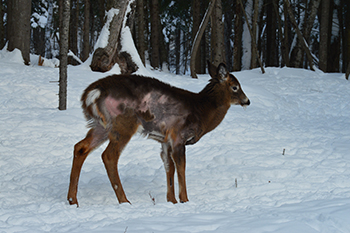Home → Fish & Wildlife → Wildlife → Living with Wildlife → Wildlife Diseases → Hair Loss in Deer
Hair Loss in Deer

What causes hair loss in deer?
The most common reason why a deer's coat looks to be in poor condition with some patchy spots and hair loss is seasonal molt. Deer molt seasonally as they transition between summer and winter coat and vice versa. These molts occur in spring, typically April and May, and fall, typically August and September. This is a normal seasonal pattern and no cause for concern.
Other noteworthy causes of hair loss in deer include lice, mange, and/or dermatophilosis, also known as rain rot.
Deer infested with lice oftentimes do not exhibit any visible signs, but some may have a coat that is patchy in appearance with thinning hair or complete hair loss in patches. Lice may cause intense itching in deer leading to excessive grooming and rubbing, which may exacerbate hair loss and damage the skin. The skin may become darkened in response to chronic inflammation.
Mange is caused by an overabundance of skin mites of various types (eg. demodectic, sarcoptiform). Deer infested with mange will exhibit hair loss and itching similar to deer infested with lice. The skin may be roughened and scabbed due to excessive grooming and rubbing of the skin ,and may make a deer more susceptible to secondary bacterial skin infections.
Dermatophilosis, or rain rot, is a bacterial skin infection that may result in hair loss, lesions and crusty scabs, and inflamed skin.
Where does this occur?
These hair loss conditions in deer may be found throughout white-tailed deer range. Dermatophilosis is more common in warm, wet areas.

Can deer be treated?
Medications exist to treat most conditions causing hair loss in deer, but there are no practical means of administering these medications in wild populations. Many cases resolve on their own when the deer are in better condition in spring/summer due to increased food resources or with seasonal environmental changes,
What is the impact on deer and the population?
None of these conditions are considered major sources of mortality in white-tailed deer in Maine. Contagious cases may become concentrated in areas of high deer density, such as at deer feeding sites in winter, which may put additional strain on animals that may be nutritionally stressed or otherwise compromised.
Can lice spread to humans or pets?
Lice found on deer are species specific and are not known to spread to humans, but people should avoid direct contact with animals exhibiting signs of hair loss, as some species of mites and dermatophilosis may be spread to humans and pets. Human cases are uncommon and treatable, though cases typically do not require treatment.
Hunters that harvest a deer with hair loss should wear gloves while handling the animal. All butchering equipment should be cleaned thoroughly after use. The conditions impact the skin of the deer, and do not impact the muscle tissues, leaving the meat safe for consumption.
What can I do?
Many conditions causing hair loss in deer are spread between deer, therefore often seen in areas of very high deer density, such as at winter feeding stations. If you observe animals with hair loss at your feeding station or bird feeders, you should spread them out so that deer less frequently contact each other. Please consult your regional MDIFW office for further suggestions. Photographs of impacted animals may be helpful.